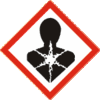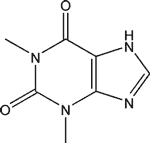Théophylline : Différence entre versions
Un article du site scienceamusante.net.
| Ligne 1 : | Ligne 1 : | ||
| − | [[Catégorie:Produit]][[Catégorie:Substance naturelle]] | + | [[Catégorie:Produit]][[Catégorie:Substance naturelle]]{{SGH08}} |
*Autres dénominations : 3,7-dihydro-1,3-diméthyl-1''H''-purine-2,6-dione | *Autres dénominations : 3,7-dihydro-1,3-diméthyl-1''H''-purine-2,6-dione | ||
*Formule brute : C<sub>7</sub>H<sub>8</sub>N<sub>4</sub>O<sub>2</sub> | *Formule brute : C<sub>7</sub>H<sub>8</sub>N<sub>4</sub>O<sub>2</sub> | ||
| Ligne 13 : | Ligne 13 : | ||
**[[Éthanol]], [[éther diéthylique]], [[chloroforme]] : légèrement soluble | **[[Éthanol]], [[éther diéthylique]], [[chloroforme]] : légèrement soluble | ||
*Aspect : poudre ou flocons | *Aspect : poudre ou flocons | ||
| + | |||
| + | {{CLP}} | ||
| + | * {{Repr. 1B}} | ||
| + | {{sgh08}} | ||
| + | {{DANGER}} | ||
| + | * {{:H360D}} | ||
{{Refs}} | {{Refs}} | ||
Version actuelle en date du 19 janvier 2024 à 14:32

|
| GHS08 |
- Autres dénominations : 3,7-dihydro-1,3-diméthyl-1H-purine-2,6-dione
- Formule brute : C7H8N4O2
- Ne pas confondre avec : théobromine
- CAS : 58-55-9
1 Propriétés physiques[1]
- Masse molaire : 180,165 g/mol
- Température de fusion : 273°C
- Solubilité :
- Eau : soluble
- Éthanol, éther diéthylique, chloroforme : légèrement soluble
- Aspect : poudre ou flocons
2 Classes et catégories de dangers - Étiquetage
Conforme au règlement CLP/SGH
- Toxicité pour la reproduction, catégorie 1B
![]() DANGER
DANGER
- H360D : Peut nuire au fœtus.
3 Références
- ↑ CRC Handbook of Chemistry and Physics, David R. Lide, 88th edition (2007-2008). ISBN 978-0-8493-0488-0
